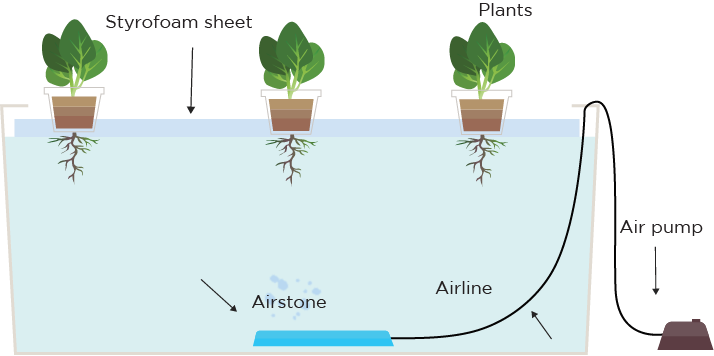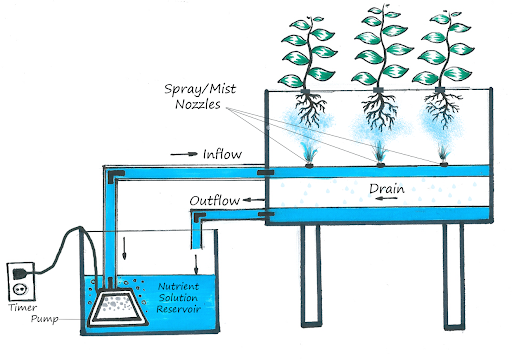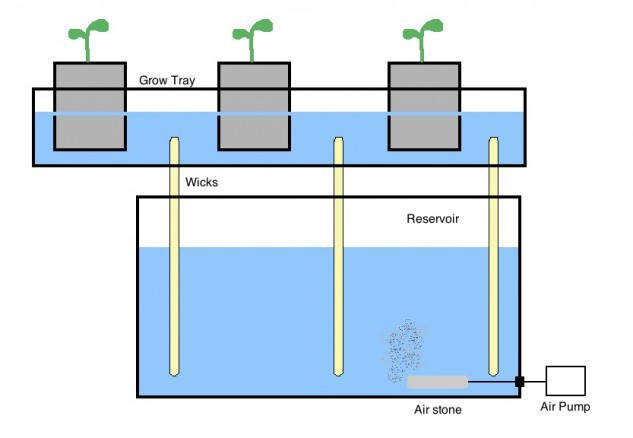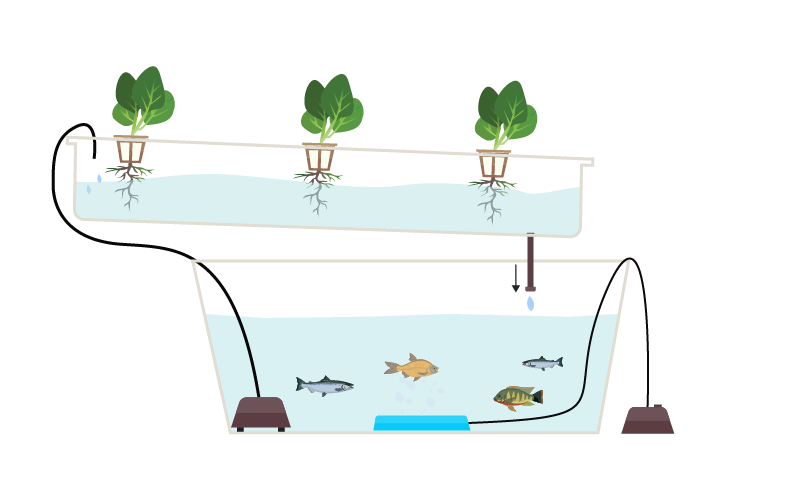Mar 12, 2019
Soilless Agriculture: An In-depth Overview

Written by: Adam French and Eric Roth
We all know that plants grow in soil but, what is soil? Well, it is certainly our most abundant growing medium, but it also contains the typical macro and micro-nutrients needed for plant growth. When water travels through soil, it takes those nutrients with it to the plant roots. In soilless agriculture, such as hydroponics, we simply deliver these same nutrients that have been pre-mixed into a water reservoir, along with high levels of oxygen, efficiently to the plant roots. There is so much to unpack when it comes to soilless agriculture, so this article is going to mainly focus on the typical hydroponic cultivation methods you can use, their advantages, and a little about aquaponics and organic methods.
Advantages of Soilless Agriculture
-
Faster growth: A more optimized feeding plan means more grow cycles per year, more yield, more food.
-
Extreme decrease in water and nutrient use: By closing the loop and recycling the water through the system, hydroponics typically uses at least 90% less water than soil-based methods. So much of the water and nutrients are wasted on traditional outdoor soil farms because only a small portion of it actually makes it to the roots, and the rest ends up in the local water supply.
-
Controlled Environment Agriculture (CEA): CEA is a method of agriculture that optimizes the temperature, humidity, airflow, and light within in the growing environment of a farm. Growers operating using greenhouses or indoor vertical farms can create optimal growing conditions 365 days a year, anywhere in the world. This is often how soilless agriculture is applied. Growing in a controlled environment also vastly improves a farm’s ability to predict crop timing, grow high quality plants, and maintain high food safety standards. No birds flying over head or animals burrowing in the field, and pesticides can be avoided. Many CEA farms use integrated pest management (predatory bugs) to prevent or deal with any pest problems. Weather will not change the farm’s ability to produce, but energy consumption will be higher than traditional farms (due to lighting and HVAC).
-
Location: The farm can and should be significantly closer to the end consumer, decreasing the carbon footprint of delivery and increasing the freshness of the product. Since there is no dependence on soil fertility, this kind of growing can be done anywhere.
-
Use significantly less space: With stacked, or vertical systems, the yield per square foot greatly increases. This is crucial in order to grow enough food for growing populations without needing to expand farmland into wetlands, forests, or other important natural ecosystems.
Types of Systems
Within hydroponics, there are several techniques to allow for optimal customization of a growing operation. Whether you’re a hand-watering hobby grower, or looking to start a massive commercial farm, there is a growing technique perfectly suited for your goals. And the best part is you don’t have to choose just one! With enough space, you can use any or all of these techniques in tandem.
Deep Water Culture (DWC)
.png)
Deep Water Cultivation
Simply put, this is floating plants on recirculating water. There are many ways to do it but often it is done on styrofoam insulation boards (4ft x 8ft). By drilling tapered (conical) holes in the boards to the size of the growing media you select, you can drop in your germinated plant and it won’t fall through. The roots are suspended in about 6 to 18 inches of a well-oxygenated nutrient solution until harvest. It’s perfect for short-statured leafy greens and herbs as they do not require much root support. DWC systems often hold a large volume of water slowing any swings in the chemistry of the solution. Additionally, if there is ever a pump malfunction in a DWC system, you would have many hours to fix it before you ran into any significant problems, like the roots drying out.

Nutrient Film Technique
Nutrient Film Technique (NFT)
This versatile technique uses channels or troughs, set up on a slight angle for drainage purposes, and running a very shallow stream of water to the roots. It can be done on a timer or with a continuous flow. The solution is held at the lowest point in a reservoir that contains a submersible pump and usually air stones for optimal dissolved oxygen levels and stagnation prevention. Once the water saturates the roots, it drains back into the reservoir. NFT is best for short-statured plants like DWC, but these systems hold much less water per plant and are more easily stackable, cleanable, and customizable for your grow space.

Ebb and Flow
Ebb and Flow (Flood and Drain)
Ebb and flow systems can be as basic as a small plastic bucket with some expanded clay pellets or other rock media that you hand water and drain. It can also be as complex as adding a large media filled bed onto an aquaponic system and flooding it with the liquid waste from the system. In every instance, the grow tray is temporarily flooded with solution every few hours, submerging the roots before returning to the reservoir. Because of the root support and oxygen levels they can provide, ebb and flow systems are great for growing pretty much anything, but especially fruiting crops. You just have to be sure that however it’s being done, the setup can support the weight of all that media and water and your containers drain completely. This article from Upstart University shows how easy it is to get started with Bato Buckets. Ebb and flow systems are low maintenance and produce high yields, but like NFT systems, a pump failure can quickly become catastrophic for your plants.
Drip System

Drip System
Drip systems are another common and simple technique whereby a pump on a timer delivers a slow feed of the solution to the base of each plant individually. The excess solution can be either returned to the reservoir or not collected. It works well with growing mediums with high water retention (i.e. coco coir, peat moss, or rockwool). When the system is working correctly, it is very low maintenance and high output, but the drip lines can get clogged, which results in dried out plants. Synthetic nutrients are the logical choice for these systems because organic materials clog lines much faster.
Aeroponics

Aeroponics
This is an innovative technique of misting the roots, which are suspended in the air, with hydroponic solution. These systems are very precise with nutrient delivery and water usage, but if you are designing your own system, aeroponics might not be the place to start. The clogging issues can be even worse than drip system as the emitters have very tiny holes. But the roots have ample oxygen and high oxygen levels means faster growth. A-frame aeroponic systems are common, using tall cones made of PVC frames, which gives the root chamber a perfect environment.
Wicking System

Wicking System
Wicking systems are the most basic and passive growing technique and another great starting point for beginners because of its low maintenance. The solution is delivered to a tray through the wicks and then to the roots via the plant’s capillary action. It has no moving parts and works great on a hobby scale, but is not the most efficient when it comes to nutrient use. There are a lot of great YouTube videos that can teach you how to easily build one of these systems, like Green Our Planet's How to Build a Wicking Hydroponic System and the Urban Gardener's How to Build a 5-Gallon Bucket Water Wicking Growing System.
Aquaponics and Organic Hydroponics
.png)
Hydroponics is not a new invention, it has been used and perfected over thousands of years throughout human history. Primitive examples of soilless techniques were discovered at the Floating Gardens in China and the Hanging Gardens of Babylon. These civilizations in many cases used aquaponics, which is raising fish and plants in the same water source. The fish actually provide the fertilizer for the plants and the plant roots filter the water for the fish. When fish are introduced to a freshwater source, they give off ammonia through their gills and waste (pee and poop!). Over time, nitrifying bacteria - naturally-occurring microorganisms - begin to grow on all the surface area under the water. This bacteria converts the fish waste into nitrites, and eventually nitrates, which is plant food. So aquaponic farms actually grow three separate, equally important things, plants, fish and beneficial bacteria. With the correct ratio of plants to fish, an aquaponic system can be a very sustainable and fun way to grow food.
That same nitrifying bacteria in aquaponics is also needed in organic hydroponic applications. Growing organically in hydroponics is biologically more closely related to aquaponics than to synthetic hydroponics. It can be a difficult and messy process, so many commercial scale operations use synthetic hydroponic methods. One reason for this is that with aquaponics and organic hydroponics, maintaining a healthy and vibrant bacterial colony is imperative, so sanitizing and flushing the majority of the water is not recommended and can cripple the overall health of the system. It can take months to “mature” your water, which is a way of saying the ammonia being introduced, through fish waste or organic nutrients, is effectively being converted to nitrates. Oxygen is the defining element of these systems so it is important to have a good flow rate and biofiltration to remove any oxygen consuming waste to avoid anaerobic activity (absence of oxygen).
Time for Action
If you’ve read this far, you are, at the very least, intrigued with growing plants. No matter the technique or what you want to grow, the first step is just getting started. You’ll probably be amazed at how easy and rewarding it can be on a small scale. Start gathering data and reading articles about companies succeeding in the space. See if there is a local hydroponic shop you can visit and talk to the people working there.
If you’re considering a commercial farm, you’ll definitely want to check out Agritecture’s Commercial Urban Farming Course, which is now available online via Agritecture Designer. Whether it is with soil or without, the world will always need more veggies growing near the people who consume them. Now, GET GROWING!!!

